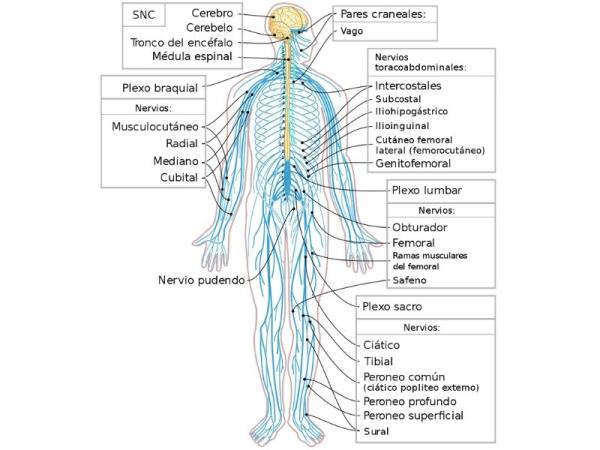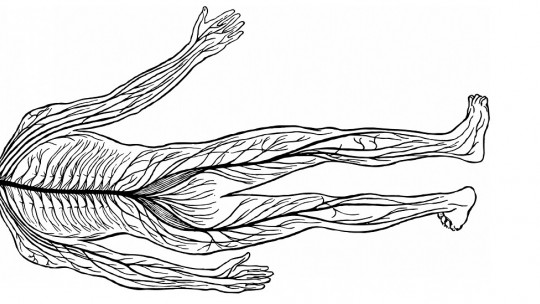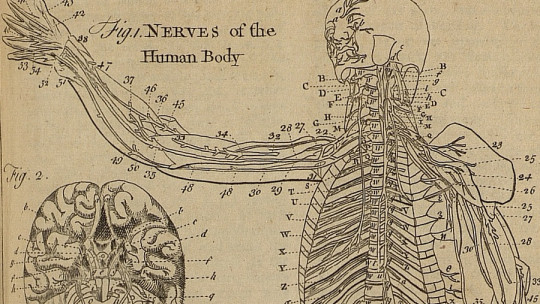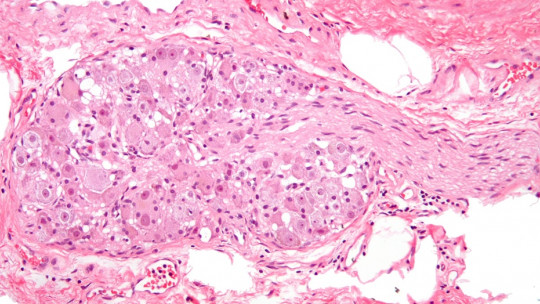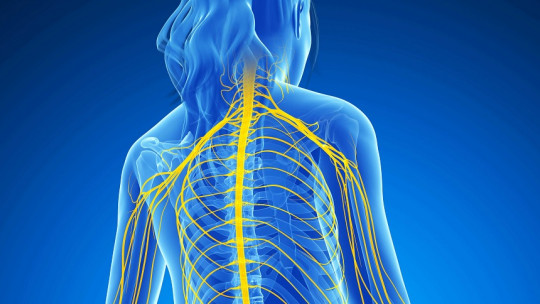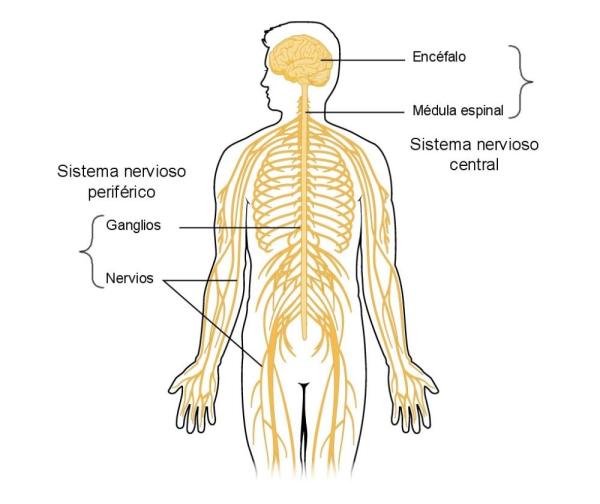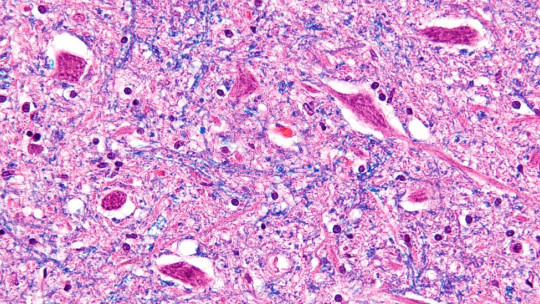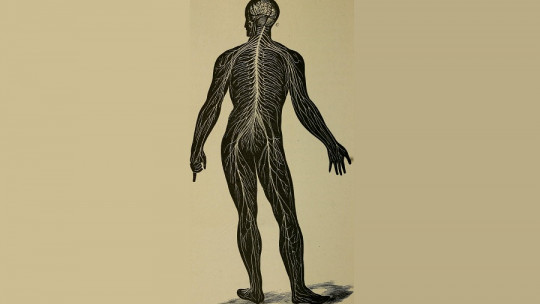
The somatic nervous system is part of the peripheral nervous system and is responsible for transmitting sensory information and sending motor control information to the skeletal muscles.
It is the main management system for voluntary movements and the nerve center of dozens of sensory and motor nerves that enter and leave the central nervous system, in connection with the skin, organs and muscles of the body.
In this article we explain what the somatic nervous system is, what its functions are, its composition and the main diseases that affect it.
The nervious system
The somatic nervous system is part of a larger whole, the nervous system, guarantor of the control and management of the vast majority of the vital functions of our body capturing stimuli from the environment and those from the body itself to transmit, process information and generate effective responses depending on what each situation requires.
From an anatomical point of view, the nervous system can be divided into two parts: the central nervous system (CNS), which includes the brain and spinal cord; and the peripheral nervous system, which includes the set of nerves and ganglia that connect the CNS with the rest of our body.
The peripheral nervous system can be divided, from a functional point of view, into two parts: the autonomic nervous system, which is composed of sensory and motor fibers that connect the central nervous system (CNS) with the visceral organs, the smooth muscles and the secretory glands; and the somatic nervous system, which regulates the voluntary functions of the body and of which we will give more details below.
The somatic nervous system (SNS)
The somatic nervous system is responsible for capturing sensory information from the environment, using sensory receptors that we have distributed throughout our body (mainly in the head, skin and extremities) and that information is transmitted to the central nervous system (CNS), which is responsible for executing the orders through the motor neurons that conduct nervous impulses. to skeletal muscles.
This system It is associated with the voluntary control of body movements, as well as the processing of sensory information that comes from the senses (sight, hearing and touch). The somatic nervous system is made up of afferent or sensory nerves and motor or efferent nerves.
The sensory nerves are responsible for transmitting body sensations to the CNS and the motor nerves are responsible for sending orders from the CNS to the body’s organs, stimulating muscle contraction.
The 43 segments of nerves that make up our body are found in the somatic nervous system. Each segment is made up of a sensory nerve and a motor nerve Of the total, 31 emerge from the spinal cord (spinal nerves), while the remaining 12 emerge from the skull (cranial nerves).
Composition of the SNS
The nerves that make up the somatic nervous system can be classified depending on the place from which they enter and exit into: cranial nerves, those that emerge directly from the brain or at the level of the brain stem; and spinal nerves, those that emerge from the spinal cord.
Cranial nerves
There are 12 pairs of cranial nerves in the somatic nervous system which emerge from the brain and have the objective of transporting sensory information, controlling certain muscles and regulating some glands and internal organs.
These are the twelve pairs of cranial nerves:
1. Olfactory nerve
It is responsible for receiving olfactory sensory information to transmit it to the olfactory bulb a structure of the brain that is responsible for processing and encoding said information to send it to higher structures of the brain.
2. Optic nerve
Receives visual sensory information to transmit it to higher brain regions responsible for vision.
3. Internal oculomotor nerve
It controls eye movements and regulates processes such as pupillary dilation and contraction.
4. Trochlear nerve
It innervates the superior oblique muscle of the eye and its main function is control eye movements (up and down, and also outwards).
5. Trigeminal nerve
It has a sensory portion and a motor portion, and is responsible for receiving somatosensory information (tactile sensations, pain, etc.) of the receptors of the face and head, in addition to controlling the muscles of chewing.
6. Abducens or abducens nerve
Its function is control the movement of the lateral rectus muscle, allowing abduction of the eye (turn in the opposite direction to the nose).
7. Facial nerve
It contains both sensory and motor fibers, is responsible for receiving information from the tongue (gustatory) receptors and somatosensory information from the ears, and manages the movements of the muscles of the neck and face involved in facial expressions.
8. Vestibulocochlear nerve
It is a sensory afferent nerve and is responsible for balance and hearing function
9. Glossopharyngeal nerve
This nerve emerges from the medulla oblongata of the brain and receives gustatory information from the back of the tongue, somatosensory information from the tonsils, pharynx, middle ear and auditory tube. It is also involved in swallowing.
10. Vagus nerve
It emerges from the medulla oblongata and innervates the pharynx, esophagus, larynx, trachea, bronchi, heart, stomach, pancreas, and liver. Receives sensitive information from all these glands and participates in cardiac and digestive processes sending information to organs and muscles.
11. Spinal accessory nerve
It is a motor nerve that is formed by the union of a spinal root and another neurocranial root. It controls muscles of the neck and head that are used for movement.
12. Hypoglossal nerve
It is mainly responsible for manage tongue movements
spinal nerves
The somatic nervous system is made up of 31 pairs of cranial nerves. These nerves connect organs and muscles to the spinal cord ; They are responsible for transmitting sensory and visceral information to the marrow and from this to the glands, and to the skeletal and smooth muscles. They innervate the entire body, except for the head and some parts of the neck.
Of the 31 existing pairs, 8 of them are cervical, 12 thoracic, 5 lumbar, 5 sacral and one coccygeal (located at the level of the pelvic floor). They are all mixed; That is, they have a sensitive part or root, where the spinal ganglion is located; and other motor part These two roots join and form the trunk of the spinal nerve, which emerges from the vertebral canal through the corresponding intervertebral foramen.
In its course, each spinal nerve emits four branches: the meningeals, which innervate the meninges of the spinal cord; the communicators, which connect with the sympathetic ganglia and are responsible for bringing information to the body related to stress and the classic fight or flight responses; the posterior ones, which innervate the deep muscles of the dorsum of the trunk and the skin; and the anterior ones, which innervate the muscles and skin of the rest of the trunk and limbs.
Features
The main functions of the somatic nervous system can be reduced to the following: transmit sensory information to the brain and connect the central nervous system with organs, muscles and skin; sending and transmitting commands to muscles to produce voluntary movements; and activate involuntary body movements or reflexes.
The process is as follows: sensory or afferent neurons transmit electrical impulses to the central nervous system and the brain; These stimuli are then processed by the central nervous system; and finally, the motor or efferent neurons are responsible for receiving the signal to send it to muscles and organs.
The somatic nervous system, in addition to managing voluntary muscle movements, It also controls reflex acts in which there is no direct intervention of the brain This occurs when a nerve pathway connects directly through the spinal cord. For example, the withdrawal reflex when we put our hand in a fire and get burned or the knee reflex, when we are hit with a hammer at the level of the patellar tendon.
SNS diseases
Disorders affecting the somatic nervous system They can seriously disable the person who suffers from them. Below are some of the most common:
1. Herniated disc
A herniated disc occurs when one of the discs in the spine becomes damaged The disc can move out of place (herniate) or rupture due to injury or strain. This generates excess pressure on the spinal nerves, causing pain, numbness or weakness in the patient.
Herniations can occur at any height of the spinal cord and symptoms will vary depending on where the injury or disc displacement occurs. When symptoms occur in the legs, the disorder is called sciatica.
2. Neuralgia
Neuralgia is a pain affecting the nerves in the face, skull, or neck, due to irritation, compression or infection thereof. It is one of the most common neuropathies (diseases of the nervous system).
The most common symptoms are more or less intense pain in different parts of the body, similar to an electric shock. This pain comes and goes suddenly, usually due to harmless stimuli such as washing your face or chewing, and usually lasts a few minutes.
3. Spinal stenosis
spinal stenosis involves a narrowing and constriction of the spinal canal (which houses the spinal cord) due to arthritis that causes overgrowth of the bones of the vertebrae and widening of the ligaments. When the growth is excessive, there may be pinching and compression on the spinal nerves, causing pain and loss of sensation in the patient.
The most common causes of spinal stenosis are: aging, arthritis (bone and rheumatoid), hereditary conditions (such as scoliosis or a narrow spinal canal), and spinal tumors, injuries, or fractures.

